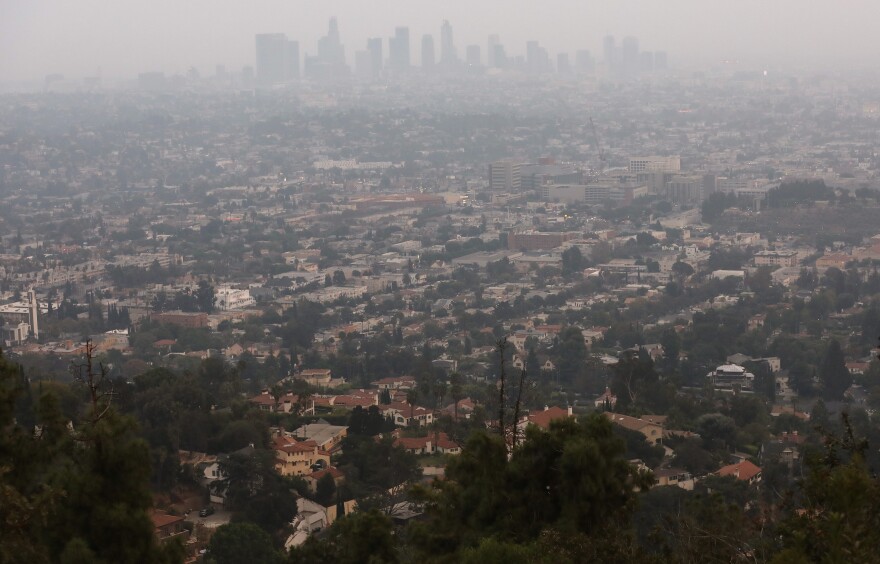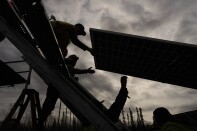This story is free to read because readers choose to support LAist. If you find value in independent local reporting, make a donation to power our newsroom today.
Climate Change Is Undoing Decades Of Progress On Air Quality

A choking layer of pollution-laced fog settled over Minneapolis last month, blanketing the city in its worst air quality since 2005. A temperature inversion acted like a ceiling, trapping small particles emitted from sluggish engines and overworked heaters in a gauze that shrouded the skyline. That haze arrived amid the hottest winter on record for the Midwest. Warmer temperatures melted what little snow had fallen, releasing moisture that helped further trap pollution.
This story was originally published by Grist. Sign up for Grist’s weekly newsletter here.
Grist is a nonprofit, independent media organization dedicated to telling stories of climate solutions and a just future.
Though summertime pollution from wildfire smoke and ozone receives more attention, climate change is making these kinds of winter inversions increasingly common — with troubling results. One in four Americans are now exposed to unhealthy air, according to a report by First Street Foundation.
Jeremy Porter, head of climate implications research at the nonprofit climate research firm, calls this increase in air pollution a “climate penalty,” rolling back improvements made over four decades. On the West Coast, this inflection point was passed about 10 years ago; air quality across the region has consistently worsened since 2010. Now, a broader swath of the country is starting to see deteriorating conditions. During Canada’s boreal wildfires last summer, for example, millions of people from Chicago to New York experienced some of the worst air pollution in the world. It was a precedent-breaking spate that saw the average person exposed to more small particulate matter than at any time since tracking began in 2006.
It’s a preview of more to come.
Since Congress passed the Clean Air Act in 1970, federal law has regulated all sources of emissions, successfully reducing pollution. Between 1990 and 2017, the number of particles smaller than 2.5 micrometers, known as PM2.5, fell 41 percent. These particulates pose a significant threat because they can burrow into the lungs and enter the bloodstream. Exposure can cause heart disease, strokes, respiratory diseases like lung cancer, and premature death. Such concerns prompted the Environmental Protection Agency to toughen pollution limits for the first time in a decade, lowering the limit from 12 micrograms per cubic meter of air to 9 earlier this month.
But a stricter standard isn’t likely to resolve the problem, said Marissa Childs, a post-doctoral researcher at Harvard University’s Center for the Environment. That’s because the agency considers wildfires an “exceptional event,” and therefore exempt from the regulation. Yet about one-third of all particulate matter pollution in the United States now comes from wildfire smoke. “The Clean Air Act is challenged by smoke,” she said, both because wildfires defy the EPA’s traditional enforcement mechanisms, and because of its capacity to travel long distances. “Are we going to start saying that New York is out of compliance because California had a fire burning?”
To get a better sense of how a growing exposure to air pollution might impact the public, First Street used wildfire and climate models to estimate what the skies might look like in the future. (Though its researchers relied on Childs’ national database of PM2.5 concentrations, she was not otherwise involved with First Street’s report.) They found that by 2054, 50 percent more people, or 125 million in all, will experience at least one day of “red” air quality with an Air Quality Index from 151-200, a level considered risky enough that everyone should minimize their exposure. “We’re essentially adding back additional premature deaths, adding back additional heart attacks,” Porter said at a meeting about the report. “We’re losing productivity in the economic markets by additionally losing outdoor job work days.”
First Street has now added its air quality predictions to an online tool that allows anyone to search for climate risks by home address. As extreme heat increases ozone and changing conditions intensify wildfires, it shows just how unequal the impacts will be. While New York City is projected to see eight days a year with the Air Quality Index at an unhealthy orange, meaning an in the range of 101 to 150, an increase of two days, the Seattle metropolitan area is expected to see almost two additional weeks of poor air. “That’s two more weeks out of only 52,” said Ed Kearns, First Street’s chief science officer. “Twelve more days of being trapped in your house, not being able to go outside — worrying about the health consequences.”
Just as the sources of pollution are unevenly distributed, so too is people’s ability to respond. “People across the board are seeking information about air quality,” Childs said, for example, searching online about pollution levels on particularly smoky days. But not everyone has the same ability to make choices to protect themselves. Childs cowrote a 2022 Nature Human Behavior paper that found behavioral responses to smoke — staying indoors, for example, or driving to work rather than waiting for the bus — are strongly correlated with income. If left to individuals, she says, “the people who have the most resources are going to be the most protected, and we’re going to leave a lot of people behind.”
In a collaboration with real estate company Redfin, First Street found early signals that suggest people are already leaving areas with poor air quality. Tarik Benmarhnia, an environmental epidemiologist at the University of California, San Diego, quibbles with those conclusions, however, saying many variables influence both air quality and residential mobility, like income and housing prices. Air pollution is a notoriously complex subject — difficult to predict even a week out, much less speculate on what might happen in three decades. “I think the most critical problem is a total absence of any discussion of uncertainty,” he said.
He also worries that First Street’s risk index could unintentionally magnify these distinctions of privilege. If potential homeowners use the database to avoid areas based on the report’s predictions, property values in those regions could fall accordingly, reducing tax bases and decreasing the ability to provide services like community clean air rooms during smoke events. “It may act like a self-fulfilling prophecy.”
Benmarhnia notes that traditional sources of air pollution, like factory emissions, show a very consistent relationship between socio-economic status, race, and higher pollution levels, a pattern that repeats across the country. Smoke and ozone don’t tend to follow these social gradients because they disperse so widely. “But wildfire smoke doesn’t come on top of nothing, it’s on top of existing inequities” like access to health care, or jobs that increase outdoor exposures, he said. “Not everybody is starting from the same place.” Benmarhnia recently published a paper finding that wildfires, in concert with extreme heat, compound the risk to cardiovascular systems. But the people most likely to be harmed by these synergies live in low-income communities of color.
“The thing about air pollution is there’s only so much you can do at individual or civil society level,” said Christa Hasenkopf, the director of the Clean Air Program at the Energy Policy Institute at the University of Chicago. “It’s a political and social issue that has to be tackled at a national level.” The university’s Air Quality Life Index measures how air pollution is contributing to early deaths around the world, aiming to provide a clearer image of the health gaps. “The size of the impact on life expectancy in two relatively geographically nearby areas can be surprising,” she says, like between eastern and western Europe.
For her part, Hasenkopf is enthusiastic about First Street’s air quality report, hoping it will help highlight some of these inequities. Though 13 people die every minute from air pollution, funding for cleaner air solutions remains limited. “That disconnect between the size of the air pollution issue, and what resources we are devoting to it is quite startling,” Hasenkopf said.










